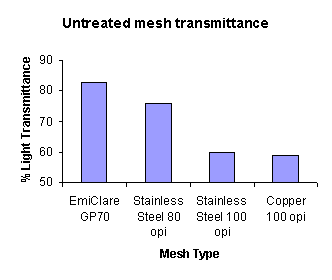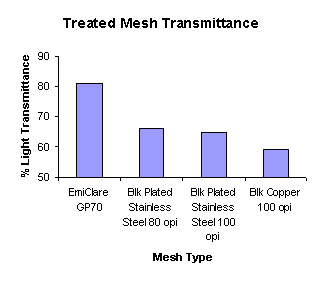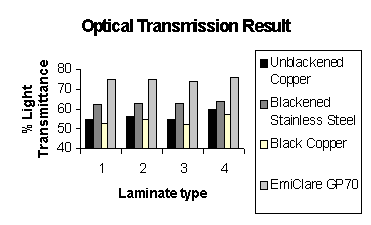
Vision with ShieldingBy Michael Dent, Managing Director, Optical Filters Ltd |
A logical approach to achieving high levels of optical performance without comprising emi shielding in the design and production of emi windows.
Conventional (existing) emi shielded windows are available in glass and various types of plastics with either mesh or a conductive coating as the shielding medium. The meshes available cover a broad range from knitted Monel meshes to high density woven meshes in copper or stainless steel wire. The conductive coatings are vacuum deposition coatings which are available from densities of 50 to 0.5 ohms/square. All of the various options available are characterised by a compromise between optical and shielding performance and the information available to the designer is further confused by a historical practise of manufacturers of these devices presenting theoretical performance as the actual performance of their devices.This paper compares the optical performance of existing devices and a new and more economical solution developed by Optical Filters Limited and trademarked under the brand EmiClareTM . Some two years ago we asked the following questions concerning the design of emi windows:
The conclusion was that there had to be a better solution to the problem and this could be found by developing a mesh specifically for shielded windows. The optical aspects are discussed in the remainder of this paper. The shielding aspects of EmiClare mesh are at least equal to the best of the conventional meshes and the details are covered in a separate paper. The optical characteristics of EmiClare windows were developed against the following requirements:
Figure 1.

Figure 2 illustrates the changes which occur with the various plating and finishing treatments.
Figure 2

Further losses in transmission occur from absorption and dispersion within the substrate and from reflection and dispersion at the surfaces of the substrates. The result of these effects is shown in Figure:III and Table:IV.
Figure 3.

| Surface Finish | Reduction in T% |
|---|---|
| Non-Glare coatings 60-70 gloss | 2-3% |
| Non-glare coatings 80-90 gloss | 1% |
| Clear Hard Coats | <1% |
| MLAR coatings on glass | <1% |
| ITO coatings 16-20 ohms/square | 5-10% |
From the above it is obvious that the optical transmission of shielded windows can only be adequately described by actual measurement of the finished window. This can be done by using a scanning spectrophotomer which can produce a printout of the characteristics of the window.
Specifiers / Designers of windows should be aware of the correct method of specifying light transmission and mark drawings and quality procedures accordingly.
The process on copper is aggressive and generally limits the wire diameter to a minimum of 0.050mm (0.002"). Copper wire diameters less than this cannot be processed without significant variation in blackening quality and mesh strength.
The plating process increases the wire diameter and reduces the mesh open area and it is difficult to control plating thickness within a 600x600mm sheet and from batch to batch. In addition this process is also a significant cost driver in emi windows.
EmiClare uses a proprietary process which eliminates the need for plating and allows the use of finer wire diameters with higher levels of light transmission. The results are summarised in Table:II.
In addition to technical performance improvements, new production methods have resulted in no cost penalties and windows produced within the stock parameters offer significant cost reductions through standardised production methods.
EmiClare mesh was developed by addressing the fundamental issues starting at the optical relationships between the viewer, the emi window and the display. To satisfy these relationships we went back to basics starting with the wire material followed by all the processes involved in producing the finished window. The end product is a family of emi windows containing stable mesh based on wire diameters of less than 0.030mm, giving high light transmission, excellent emi shielding and minimum optical disturbance. The detail of the design and mesh structure is proprietary information but the end result of higher light transmission and reduced visibility of the mesh is clearly demonstrated by comparing an EmiClare GP70 window with any other emi window.
Visual distractions are caused by a lack of uniformity in the mesh which attracts the eye to the areas of difference. Apart from the cosmetic issues these visual distractions are also responsible for inducing eye fatigue caused by the repetitive focussing from the mesh to the display information.
Moiré Fringing patterns are light and dark moving bands which are caused by optical interference between the pixel structure of the display and the square apertures of the mesh. Rotating the mesh between 17- 45 degrees can reduce this effect but unless the mesh is completely uniform in structure small areas of the display continue to show Moiré effects. One of the innovations on the EmiClare mesh is the development of rectangular apertures. This allows mesh geometries to be woven which can be matched to the pixel structure of a specific display type thus preventing Moiré effects. A general mesh geometry has also been developed which when set at 45 degrees eliminates these effects on any display.
EmiClare GP70/45 = a general purpose EmiClare mesh with light transmission >70%. Mesh set at 45 degrees. EmiClare CRT75 = a mesh specifically optimised for CRT displays. Light transmission >75%. Mesh angle 90 degrees.
This simple system eliminates the complicated description of the mesh detail such as wire diameter, mesh count, metal type, plating detail, mesh angle, etc. and focuses on the factors which determine the emi windows performance when placed in front of the display. The high level of actual light transmission in association with the other issues discussed above offer the designer the opportunity to specify emi windows which will cause a minimum of optical disturbance whilst giving high level rf attenuation across a wide spectrum of frequencies from 1 MHz to over 10 GHz.
 © Nutwood UK Ltd 2001 |
Eddystone Court - De Lank Lane St Breward - BODMIN - PL30 4NQ Tel: +44 (0)1208 851530 - Fax: +44 (0)1208 850871 nutwooduk@nutwood.eu.com |
|
|
|